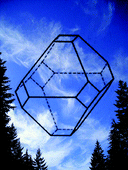There is growing evidence that a metastable phase of ice, cubic ice, plays an important role in the Earth’s troposphere and stratosphere. Cubic ice may also be important in diverse fields such as cryobiology and planetary sciences. Using X-ray diffraction, we studied the formation of cubic ice in pure water droplets suspended in an oil matrix as a function of droplet size. The results show that droplets of volume median diameter 5.6 μm froze dominantly to cubic ice with stacking faults. These results support previous suggestions that cubic ice is the crystalline phase that nucleates when pure water droplets freeze homogeneously at ∼235 K. It is also shown that as the size of the water droplets increased from 5.6 to 17.0 μm, the formation of the stable phase of ice, hexagonal ice, was favoured. This size dependence can be rationalised with heat transfer calculations. We also investigated the stability of cubic ice that forms in water droplets suspended in an oil matrix. We observe cubic ice up to 243 K, much higher in temperature than observed in many previous studies. This result adds to the existing literature that shows bulk ice Ic can persist up to ∼240 K. The transformation of cubic ice to hexagonal ice also showed a complex time and temperature dependence, proceeding rapidly at first and then slowing down and coming to a halt. These combined results help explain why cubic ice forms in some experiments described in the literature and not others.

You have access to this article
 Please wait while we load your content...
Something went wrong. Try again?
Please wait while we load your content...
Something went wrong. Try again?


 Please wait while we load your content...
Please wait while we load your content...